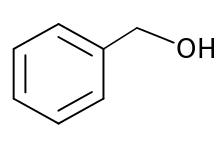Structural Biochemistry/Organic Chemistry/Organic Functional Group
< Structural Biochemistry < Organic ChemistryGeneral information
The term “functional group” is one that is used almost exclusively in organic chemistry. In organic chemistry, functional groups are a set of specific atoms within a molecule that determine the molecule’s overall reactivity and properties. Small differences in functional groups, like the difference between an aldehyde and a ketone, can result in drastic differences in the properties and reactivity of the molecules. Compounds that have the same functional groups will have the same type of reactivity, though small deviances will result if other substituents or functional groups are present on the molecule.
There are 7 important functional groups in the chemistry of life: Hydroxyl, Carbonyl, Carboxyl, Amino, Thiol, Phosphate, and aldehyde groups.
1) Hydroxyl group: consists of a hydrogen atom covalently bonded to an oxygen atom. The hydroxyl group is denoted by -OH in chemical structures and has a valence charge of -1 when in the hydroxyl ion form. It is present in Alcohols and Carboxylic Acid molecules.
2) Carbonyl group: is written as a covalent C=O double bond. It is a very polar molecule and the carbonyl carbon can serve as a reaction site for many reactions. It is present in Aldehydes, Ketones, Esters, Anhydrides, and Carboxylic Acids.
3) Carboxyl group: is the monovalent group -COOH, consisting of a carbonyl group bound to a hydroxyl group. It is the main functional group in organic acids (carboxylic acids), as the Hydrogen can dissociate due to the strong stabilizing resonance that forms between the two oxygens when deprotonated.
4) Amino group: The amino group (–NH2) consists of one atom of nitrogen attached by covalent bonds two atoms of hydrogen, and a spot where it is attached to an alkyl group, or another hetero atom. This leaves a lone valence electron pair on the nitrogen which is available for bonding to another atom.
5) Thiol group: a fuctional group containing a sulfur atom bonded to a hydrogen atom. General formula: -SH. The amino acid cysteine contains a thiol group. It is the thiol derivative of a hydroxyl group, and can undergo similar reactions.
6) Phosphate group: A functional group or radical comprised of phosphorus attached to four oxygen (a diester), and with a net negative charge, thus represented as PO4-. The phosphate group is important in living things in varying ways. Firstly, it is an important structural backbone component of nucleotides, which is the basic structural unit of DNA and RNA. Secondly, it is used as an electron transfer component of energy-rich molecules, such as ATP. Thirdly, it is also bound to coenzymes like NADP / NADPH involved in anabolic reactions (such as photosynthesis in plants and lipid synthesis in animals). It is also a part of the hydrophilic head of phospholipids in biological membranes.
7) Aldehyde group: Aldehydes are the second compound containing the carbonyl group (C=0). In aldehydes, one of the two groups attached to the carbonyl carbon is an alkyl group, while the other is a hydrogen atom. This means that aldehyde carbonyl occur at the end of a chain of carbon atoms (i.e. in sugars, R-CHO is at the end of a chain, while a carbonyl inside the chain attached to two carbons is a ketone). They can form acetals and hemiacetals when exposed to water, or in the presence of hydroxy groups. When an aldehyde group is the highest priority functional group present in the molecule, it is names as an alkanal (note, the -e is dropped). The numbering scheme used will be the one that gives the carbonyl carbon atom the lowest possible number (i.e. number 1). Other functional groups are located by this numbering scheme. Since the carbonyl group is always at carbon number 1, there is no need to indicate the location. It is possible to have the -CHO group directly attached to a ring. If it is the highest priority group in the molecule, the ring is a substituent to the aldehyde and it is named as a cycloalkyl carbaldehyde or cycloakanecarbaldehyde (an older way is as a carboxaldehyde). There are a number of compounds which were named before IUPAC developed the standardized nomenclature rules. Many of these compounds are still referred to by these common names.
Other common functional groups include:[1]
- Haloalkanes: can also be named as alkyl halides despite the fact that the halogens are higher priority than alkanes. The alkyl halide nomenclature is most common when the alkyl group is simple.

- Ethers: If both groups are simple alkyl groups, then the ether is usually named as alkyl alkyl ether. If the two alkyl groups are the same, then it's a dialkyl ether.
- Thiols: A sulfur-containing organic compound having the general formula RSH, where R is another element or radical.
- Alkenes: The root name is based on the longest chain containing both ends of the alkene unit, the C=C. The chain is numbered so as to give the alkene unit the lowest possible numbers. The locant for the first carbon of the alkene is used in the name.
- Alkynes: The alkynes are the third homologous series of organic compounds of hydrogen and carbon, where there is at least one triple-bond between the atoms in the molecules.
- Aromatic Compounds: a hydrocarbon containing one or more benzene rings that are characteristic of the benzene series of compounds.

- Anhydrides: are used in the preparation of esters. Ethyl acetate and butyl acetate (from butyl alcohol and acetic anhydride) are excellent solvents for cellulose nitrate lacquers. Acetates of high-molecular-weight alcohols are used as plasticizers for plastics and resins. Cellulose and acetic anhydride give cellulose acetate, used in acetate rayon and photographic film. The reaction of anhydrides with sodium peroxide forms peroxides (acetyl peroxide is violently explosive), used as catalysts for polymerization reactions and for addition of alkyl halides to alkenes. In Friedel-Crafts reactions, anhydrides react with aromatic compounds, forming ketones such as acetophenone.
Anhydrides react with water to form the parent acid, with alcohols to give esters, and with ammonia to yield amides; and with primary or secondary amines, they furnish N-substituted and N,N-disubstituted amides, respectively.
Read more: http://www.answers.com/topic/acid-anhydride#ixzz2DkMTM1Db
Read more: http://www.answers.com/topic/acid-anhydride#ixzz2DkMNN84B
- Esters: is any of a class of organic compounds corresponding to the inorganic salts and formed from an organic acid and an alcohol.
- Nitriles: are typically undergo nucleophilic addition to give products that often undergo a further reaction. The chemistry of the nitrile functional group, C=N, is very similar to that of the carbonyl, C=O of aldehydes and ketones.
References
- ↑ Schore, Neil E. (2011). Organic Chemistry Structure and Function 6th Edition. W. H. Freeman